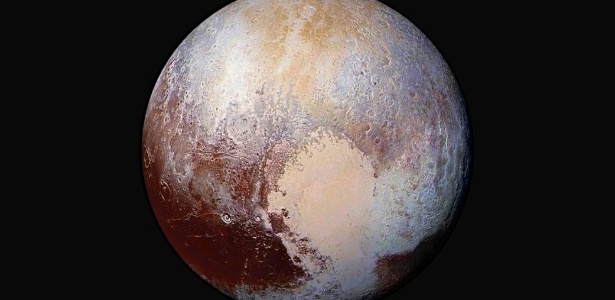Scientists have already noticed that Pluto has a heart-shaped region made up of ice. But how did this happen?
According to research by the French scientists Tanguy Bertrand and François Forget, the existence of this glacier is the result of a combination of local surface features and atmospheric processes.
In the study, published in Nature in 2016, researchers detailed the structure of giant ice made up of frozen nitrogen mixed with carbon monoxide and methane.
It covers an area four kilometers deep and a thousand kilometers wide in the Sputnik Plain of Pluto.

Pluto’s heart was the subject of memes at the time of its discovery
Photo: reproduction
To understand the origins of this glacier, the two scientists conducted numerical simulations of the evolution of the chemical components of the dwarf planet’s ice deposits over the course of 50,000 Earth years. They found that the terrain affected the formation of the glacier, intensifying the cooling of the ice.
Weather cycles also showed seasonal frosts that match data collected by NASA’s New Horizons mission and observations of polar flares seen since 1985.
Scientists’ simulations indicated that these seasonal frosts are expected to disappear within the next decade. The study authors say that future observations may provide new opportunities to test their models.
Ice “volcanoes”
Another study published in Nature Communications in March of this year highlights that there is more evidence that ice “volcanoes” were active until recently on Pluto.
Instead of spewing lava, they’re spewing a thick, muddy mixture of water and ice, “or perhaps a solid liquid like a glacier” from Earth, a planetary scientist at the South East Research Institute in Colorado, Kelsey Singer, told AFP.
The search was made possible by analyzing data and images generated by the New Horizons probe, the first spacecraft that explored Pluto in 2015.
Pluto was once a planet
Pluto was discovered in 1930 and has been highlighted for years as the ninth planet in the solar system.
However, in 2006, astronomers from the International Astronomical Union I decided to take her out of this category.
In general, a planet is considered as such when it is a celestial body, without its own light, and orbits a star.
In the case of Pluto, astronomers considered it too small. Another fact is that its orbit relative to the Sun is influenced by the orbit of Neptune. Therefore, it is not parallel to the other planets in the solar system.
The change was controversial. In 2019, NASA stated that Pluto should indeed be considered a planet, reigniting discussions.
In 2021, a new group of scholars argued that his demotion was based on reactionary thinking. To date, Pluto is still not classified as a planet.

“Wannabe internet buff. Future teen idol. Hardcore zombie guru. Gamer. Avid creator. Entrepreneur. Bacon ninja.”

